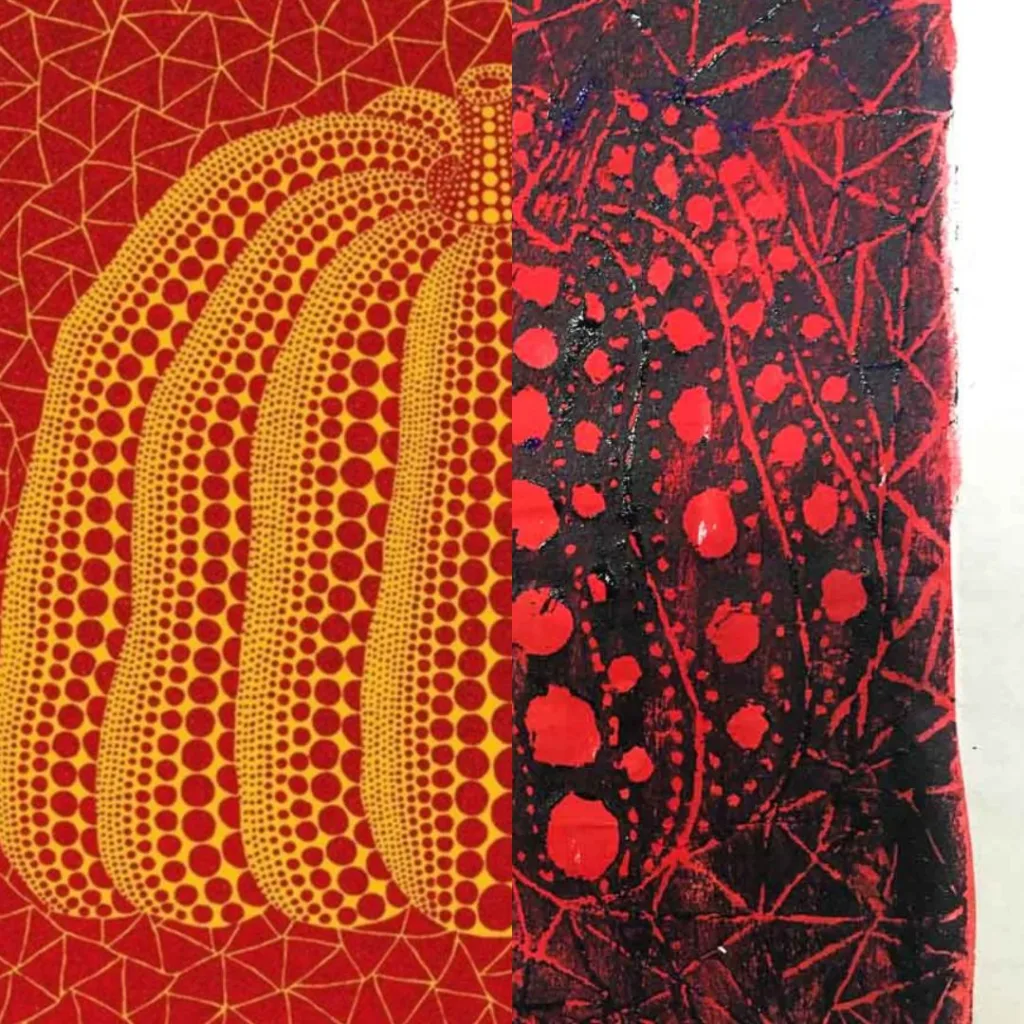Introduce your students or kids to the world of Yayoi Kusama with this simple yet engaging Halloween printmaking project for kids.
Inspired by Kusama’s iconic polka-dotted pumpkins, this activity allows children to create their own pumpkin art while exploring basic printmaking techniques. Perfect for classrooms or DIY Halloween craft sessions, this project combines art history with fun, making it an ideal way for kids to embrace creativity during the spooky season. Best of all, it’s an easy, mess-free alternative to pumpkin carving!
Yayoi Kusama is certainly one of the most recognizable artists today.
Born in Japan in 1929, Kusama is now mostly known for her iconic polka dot artworks, but her artistic journey spans decades and includes everything from painting and sculpture to performance and immersive installations. Her art is instantly recognizable for its playful yet powerful use of dots, especially when they’re spread across her larger-than-life pumpkins or her famous Infinity Mirror Rooms.
Read also:
- 21 Children’s Books about Famous Artists Kids Will Love
- 8 of the Best Spooky Artworks in Art History
So, why dots? For Kusama, dots represent more than just a fun pattern—they are a way of dissolving the boundaries between objects, spaces, and even herself. She often talks about “self-obliteration,” where covering everything in dots makes it all blend together, disappearing into infinity. In a way, dots help Kusama express her feeling of becoming one with the universe.
She has covered entire rooms, furniture, and even her own body with dots, making everything and everyone seem like they’re part of a much larger, endless field of tiny, colorful circles. It’s both whimsical and profound!
And let’s not forget the pumpkins! Kusama’s love for pumpkins dates back to her childhood in rural Japan, where she found comfort in their quirky, familiar shapes. To her, pumpkins are friendly, warm, and a little bit strange—just like her art. By covering pumpkins in dots, she transforms them from simple gourds into symbols of infinity, beauty, and creativity.
Read also:
- No-Carve Sugar Skull Pumpkin Painting: A Fun Halloween & Day of the Dead Craft for Kids
- Mariachi Skulls & Día de los Muertos: A Creative Woodblock Printing Project for Kids
Now, with Halloween right around the corner, what better way to combine Kusama’s art with the festive spirit than by creating your own dotted pumpkins? Let’s dive into this fun printmaking activity inspired by Kusama’s polka-dotted world.
Yayoi Kusama Pumpkin Printmaking Activity: How-To Guide
This simple printmaking activity will guide kids through creating their own dot-covered pumpkins inspired by Yayoi Kusama’s famous artwork. Using styrofoam or KT board as the printing plate, children can create vibrant and repetitive dot patterns, bringing Kusama’s style to life in a way that perfectly fits the Halloween season
Materials You’ll Need:
- Tempera paint for background (yellow, red, or any bold color)
- Black acrylic paint for printing (or printmaking ink)
- Styrofoam or KT board
- Ballpoint pens, pencils, or any tool with different diameters for making impressions
- Paintbrush or roller for applying paint
- Paper, we use Xuan paper
- Reference images
- (optional) Hard copies of Kusama’s works and carbon paper for tracing them on the plate
Step 1: Prepare the Styrofoam Plate
Instruction:
Before class starts, cut the styrofoam or KT board into rectangles or squares (around 5×7 inches). Prepare one for each child.
These will be used as printing plates where they will create their designs.
Step 2: Sketch the Pumpkin Design
Instruction:
Provide each child with a styrofoam plate and a ballpoint pen or pencil. Have them start by lightly sketching the outline of a pumpkin on their styrofoam. Encourage them to divide the pumpkin into sections with curved lines, just like a real pumpkin. Then, guide them to fill the pumpkin with dots of different sizes using the pens or tools with varying diameters to make impressions.
Another options is to provide photocopies of Kusama’s work and carbon copy paper to directly trace the image onto the printing plate.
Classroom Tip:
Let them know that it’s okay if their dots or lines aren’t perfect—the mroe texture the more interesting the final print will be!
For younger children, demonstrate on your own styrofoam plate how to press gently to create indentations, rather than tearing through the styrofoam.
Step 3: Prepare the Background Paper
Instruction:
Allow each child to choose a background color from a small selection (red, yellow, blue, or green—similar to Kusama’s favorite palette).
Have them paint a flat layer of color on the paper before moving to the printing step. If possible, have children prepare several sheets in different colors, as they can print multiple versions of their artwork.
Step 4: Apply Paint to the Styrofoam
Instruction:
Once the pumpkin design is ready and the background paper has dried, guide the children to apply black acrylic or tempera paint to the surface of their styrofoam plates using a brush or roller. Ensure the paint covers the entire surface evenly without pooling.
Step 5: Printing the Pumpkin Design
Instruction:
If using Xuan paper (or another thin paper), place the paper onto the inked plate rather than the other way around. This allows the children to press down and smooth the paper over the plate, ensuring better adhesion and a clearer print. Repeat this process for all the background colors and variations.
Tip:
Encourage them to experiment with different background colors and see how the black print contrasts with each one.
Step 6: Editioning and Signing the Artwork
Instruction:
Teach the children how to properly edition their prints by numbering them (for example, 1/3, 2/3, etc.), and adding their signature below the artwork. This introduces them to an important practice in printmaking, emphasizing the value of their work as part of an artistic process.

